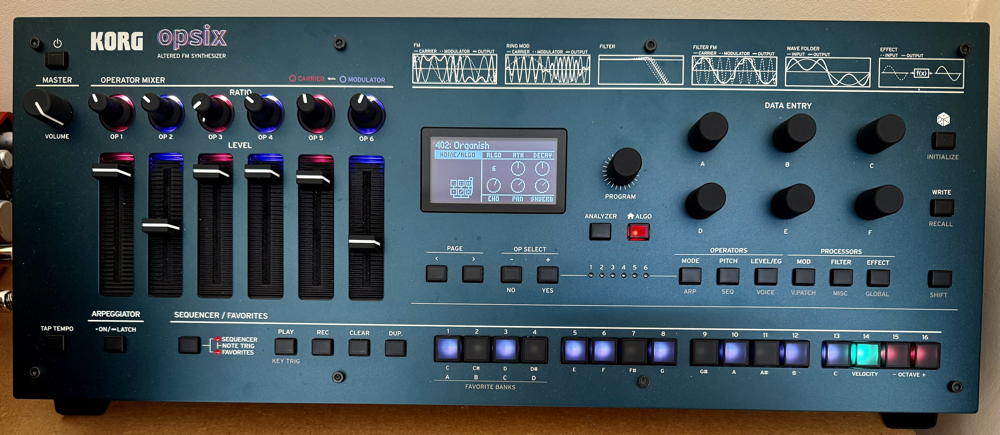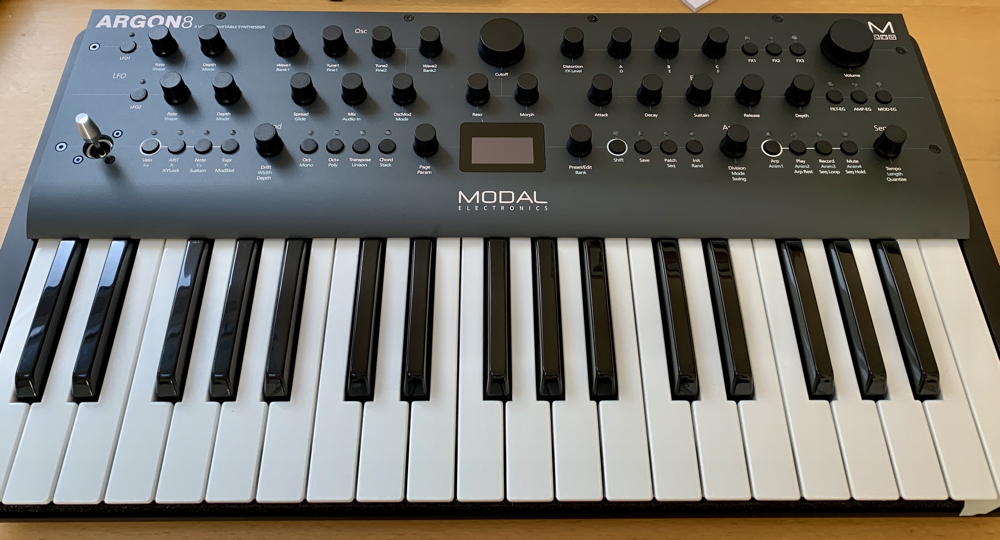Previous instruments
Synthesizers
 |
Waldorf Iridium The Iridium is more of a 'music workstation' than a simple synth with multiple synthesis methods, dual filters, six LFOs & envelopes, seemingly endless mod slots, and fine level control for virtually every stage of sound generation. All this complexity is managed with a combination of dedicated controls on the front panel and a touchscreen that gives easy access to deeper settings with useful & usable graphic feedback. The tones are deep, rich, & full and the workflow is intuitive & responsive, the only problem is knowing when to stop tweaking a patch with finer & finer adjustments. I upgraded to the Iridium from its little sister the Blofeld (see below) and it has remained my primary instrument ever since. My albums Solace, Insight, Migrant & Play were produced entirely on the Iridium. |
 |
Korg Opsix FM (Frequency Modulation) is a notoriously difficult synthesis technique and the Opsix is Korg's attempt to make it more manageable. The synth goes well beyond 'standard' FM with six operators having multiple modes, three auxiliary envelopes and LFOs, three effects slots with a wide range of options, and a large bank of mod slots. The interface works really well with a module selection and six encoders that avoid the need for menu diving but it's the six ratio & level controls that make the most difference, allowing 'sweet spots' to be (fairly) easily found. The sounds are rich, varied, & interesting and although I still tend to 'discover' rather than 'craft' tones I'm getting a much better feel for FM in action. |
 |
Modal Argon 8 This is a (relatively) straightforward wavetable synthesizer with the features you'd expect from a mid-sized polysynth. What makes it special (for me) are the wonderfully rich & sparkling wavetables, the 'control per function' layout that (mostly) avoids needing to dive through menus, and the excellent 3-octave keyboard. The Argon 8's hands-on interface was a big step forward for me in creating my own sounds from scratch, after several synths with small & fiddly controls. And its wavetables remain some of the best I've ever heard. My albums Beneath, Crafted, Tintinnalogia, Lux, and Intempate were created with the Argon 8 |
 |
Arturia KeyStep Pro A 4-channel MIDI sequencer which manages to be both fully featured and easy to use. This was an upgrade from the BeatStep Pro. |
 |
Ayodo Anyma Phi An interest in physical modelling synthesis, where strings, pipes, & blocks are replicated in software, led me to buy a secondhand Anyma Phi. This quirky machine had a novel control layout - fiddly on the device itself but much more usable with its dedicated app - and produced some wonderful sounds, unlike anything I'd used before. Unfortunately I couldn't get to grips with physical synthesis, my patches would often drift into becoming unstable (and often out of tune). It was a fascinating area to explore but a bit too much like a science project to be enjoyable. My album Corpus was produced entirely on the Anyma Phi. |
 |
ASM Hydrasynth The Hydrasynth lies somewhere between the Argon 8 and the Iridium, a wavetable synth with a control layout that provides deep editing without lots of menu diving. Selecting a module (oscillator, filter, envelope, etc.) changes the options in the control matrix, a simplified version of the Iridium's touchscreen, and illuminated surrounds show the current values. The basic tones are full & interesting, there are lots of LFO's, envelopes, & mod slots, and the interface is intuitive & easy to use. I enjoyed using the Hydrasynth but it fell too close to the other wavetable synths and eventually I let it go. My album Eden was produced (almost) entirely on the Hydrasynth. |
 |
Arturia MicroFreak The MicroFreak was a delightfully oddball instrument, a huge collection of different synthesis methods in a tiny package that managed to condense their complexities into a small but surprisingly powerful set of controls. The layout was sparse but it managed to provide quick & intuitive soundbuilding, the sounds were enormously varied, and the strange capacitive keyboard was (mostly) more usable than expected. This was a really fun synth, easy to use and often leading into strange & unusual sonic areas. Unfortunately its limitations slowly started to grate - the lack of real polyphony, mono output, and no onboard effects being the big drawbacks for me. The larger MiniFreak fixed most of these issues but its minikeys keyboard made it a bit awkward to integrate into my setup so I decided not to upgrade and instead sold the MicroFreak. My album Microfreak was produced entirely on the Microfreak. |
 |
Waldorf Blofeld The Blofeld was my first 'proper' synth after returning to electronic music in my 50s, a secondhand purchase as I was wary of spending too much on what could turn out to be an old man's folly. The small unit contained a very powerful synth with PPG-style wavetables and virtual analog tones, multiple filters, envelopes, & LFOs, and a full set of onboard effects. It had an amazing range of wonderful sounds although the fiddly interface meant I tended to tweak presets rather than set up patches from scratch. This synthesizer really took my musical creativity to a new level with its lush sounds & vast range. After many happy years with it I upgraded to the larger Iridium. I produced several albums with the Blofeld. Witness and Stavro used it as the sole synthesizer while Vigil, Past lives, cloven, Tryst, Tribe, and stonechildren also featured the Korg Volcas. |
 |
Korg Volcas The Volcas were my reintroduction to electronic music after many, many years without playing. They were small & cheap (so I could justify the outlay to myself) but were capable of producing a good set of sounds from their limited controls. Each unit included an integrated sequencer which could be synchronised with the others, allowing me to build up a multi-part arrangement with some careful programming and deft switching between patterns. I started off with the Keys, Bass, and Sample (used for drums) units before adding the FM later on. I had huge fun making music with the Volcas and they were the gateway back into electronic music for me. The controls were small & fiddly (and inconsistent between units) and they each had their own frustrating quirks but despite this they provided a way to build a piece of music quickly and (mostly) enjoyably. You can hear the results on my Volca tunes page. |
Back in my 20s and 30s I played a variety of electronic instruments, starting off with a Stylophone going through various effects pedals and progressing on to a Roland 101/102 and Roland TB-303. My last synth from this period was a Korg M1 which I used for home composition with my Atari 520 ST home computer.